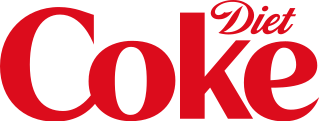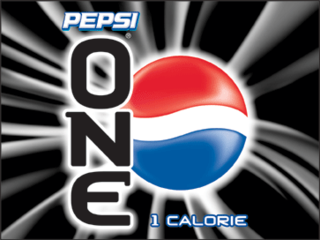
Aspartame is an artificial non-saccharide sweetener 200 times sweeter than sucrose and is commonly used as a sugar substitute in foods and beverages. It is a methyl ester of the aspartic acid/phenylalanine dipeptide with brand names NutraSweet, Equal, and Canderel. Aspartame was approved by the US Food and Drug Administration (FDA) in 1974, and then again in 1981, after approval was revoked in 1980.

Cola is a carbonated soft drink flavored with vanilla, cinnamon, citrus oils, and other flavorings. Cola became popular worldwide after the American pharmacist John Stith Pemberton invented Coca-Cola, a trademarked brand, in 1886, which was imitated by other manufacturers. Most colas originally contained caffeine from the kola nut, leading to the drink's name, though other sources have since been used. The Pemberton cola drink also contained a coca plant extract. His non-alcoholic recipe was inspired by the coca wine of pharmacist Angelo Mariani, created in 1863.

Sucralose is an artificial sweetener and sugar substitute. The majority of ingested sucralose is not broken down by the body, so it is noncaloric. In the European Union, it is also known under the E number E955. It is produced by chlorination of sucrose, selectively replacing three of the hydroxy groups—in the C1 and C6 positions of fructose and the C4 position of glucose—to give a 1,6-dichloro-1,6-dideoxyfructose–4-chloro-4-deoxygalactose disaccharide. Sucralose is about 320 to 1,000 times sweeter than sucrose, three times as sweet as both aspartame and acesulfame potassium, and twice as sweet as sodium saccharin.

A sugar substitute is a food additive that provides a sweetness like that of sugar while containing significantly less food energy than sugar-based sweeteners, making it a zero-calorie or low-calorie sweetener. Artificial sweeteners may be derived through manufacturing of plant extracts or processed by chemical synthesis. Sugar substitute products are commercially available in various forms, such as small pills, powders, and packets.

Diet Coke is a sugar-free and low-calorie soft drink produced and distributed by the Coca-Cola Company. It contains artificial sweeteners instead of sugar. Unveiled on July 8, 1982, and introduced in the United States one month later, it was the first new brand since Coca-Cola's creation in 1886 to use the Coca-Cola trademark. The product quickly overtook the company's existing diet cola, Tab, in sales.

Cyclamate is an artificial sweetener. It is 30–50 times sweeter than sucrose, making it the least potent of the commercially used artificial sweeteners. It is often used with other artificial sweeteners, especially saccharin; the mixture of 10 parts cyclamate to 1 part saccharin is common and masks the off-tastes of both sweeteners. It is less expensive than most sweeteners, including sucralose, and is stable under heating. Safety concerns led to it being banned in a few countries, though the European Union considers it safe.

Acesulfame potassium, also known as acesulfame K or Ace K, is a synthetic calorie-free sugar substitute often marketed under the trade names Sunett and Sweet One. In the European Union, it is known under the E number E950. It was discovered accidentally in 1967 by German chemist Karl Clauss at Hoechst AG. In chemical structure, acesulfame potassium is the potassium salt of 6-methyl-1,2,3-oxathiazine-4(3H)-one 2,2-dioxide. It is a white crystalline powder with molecular formula C
4H
4KNO
4S and a molecular weight of 201.24 g/mol.

Pepsi One, corporately styled PEPSI ONE, was a sugar-free cola, marketed by PepsiCo in the United States as an alternative to regular Pepsi and Diet Pepsi.

Tab was a diet cola soft drink produced and distributed by The Coca-Cola Company, introduced in 1963 and discontinued in 2020. The company's first diet drink, Tab was popular among some people throughout the 1960s and 1970s as an alternative to Coca-Cola. Several variations were made, including a number of fruit-flavored, root beer, and ginger ale versions. Caffeine-free and clear variations were released in the late 1980s and early 1990s.
Diet Rite is an American brand of no-calorie soft drinks that was originally distributed by the RC Cola company.

Coca-Cola C2 was a cola-flavored beverage introduced by The Coca-Cola Company first in Japan, then later on June 7, 2004 in the United States, in response to the low-carbohydrate diet trend. This Coke product was marketed as having half the carbohydrates, sugars and calories compared to standard Coca-Cola. It contained aspartame, acesulfame potassium, and sucralose in addition to the high fructose corn syrup typically found in cola beverages distributed in America.

Fresca is a grapefruit-flavored citrus soft drink created by The Coca-Cola Company. Borrowing the word Fresca from Italian, Spanish and Portuguese, it was introduced in the United States in 1966. Originally a bottled sugar-free diet soda, sugar sweetened versions were introduced in some markets.

Diet Pepsi is a diet carbonated cola soft drink produced by PepsiCo, introduced in 1964 as a variant of Pepsi with no sugar. First test marketed in 1963 under the name Patio Diet Cola, it was re-branded as Diet Pepsi the following year, becoming the first diet cola to be distributed on a national scale in the United States. In the 1960s and 1970s, its competition consisted of the Coca-Cola Company's now-discontinued Tab. The United States represents the largest single market for Diet Pepsi.

Shasta Beverages is an American soft drink manufacturer that markets a value-priced soft drink line with a wide variety of soda flavors, as well as a few drink mixers, under the brand name Shasta. The company name is derived from Mount Shasta in northern California and the associated Shasta Springs.

Sierra Mist is a discontinued lemon-lime flavored soft drink line. Originally introduced by PepsiCo in 1999, it was eventually made available in all US markets by 2003. The name is a play on Mountain Dew: "sierra" is the Spanish word for "mountain range" and both mist and dew are composed of water droplets. The drink was rebranded as "Mist Twst" in 2016, but reverted to Sierra Mist in 2018. In early 2023, Sierra Mist was replaced by Starry. The brand was aimed at competing with The Coca-Cola Company's Sprite brand and Keurig Dr Pepper's 7 Up.

Equal is an American brand of artificial sweetener containing aspartame, acesulfame potassium, dextrose and maltodextrin. It is marketed as a tabletop sweetener by Merisant, a global corporation which also used to own the well-known NutraSweet brand when it was a subsidiary of Monsanto and which has headquarters in Chicago, Illinois, Switzerland, Mexico, and Singapore. In French Canada, Equal is known as "Égal".
Fruit2O, formerly manufactured by Kraft, is a lightly flavored, non-carbonated water beverage introduced in 1999. Fruit2o was introduced to compete not only with the bottled water market but also with the soft drink market. Sunny Delight Beverages purchased the Veryfine Products line from Kraft in 2007.

Pepsi Zero Sugar, is a zero-calorie, sugar-free, formerly ginseng-infused cola sweetened with aspartame and acesulfame K, marketed by PepsiCo. It originally contained nearly twice the caffeine of Pepsi's other cola beverages. Before a recipe change in late 2022, Pepsi Zero Sugar contained 69 milligrams of caffeine per 355 mL (12.5 imp fl oz), versus 36 milligrams in Diet Pepsi.

Sprite is a clear, lemon and lime-flavored soft drink created by the Coca-Cola Company. Sprite comes in multiple flavors, including cranberry, cherry, grape, orange, tropical, ginger, and vanilla. Ice, peach, Berryclear remix, and newer versions of the drinks are artificially sweetened. Sprite was created to compete primarily against 7 Up.

Pepsi Next is a discontinued cola-flavored carbonated soft drink produced by PepsiCo. It was a variant of the Pepsi cola range.

















